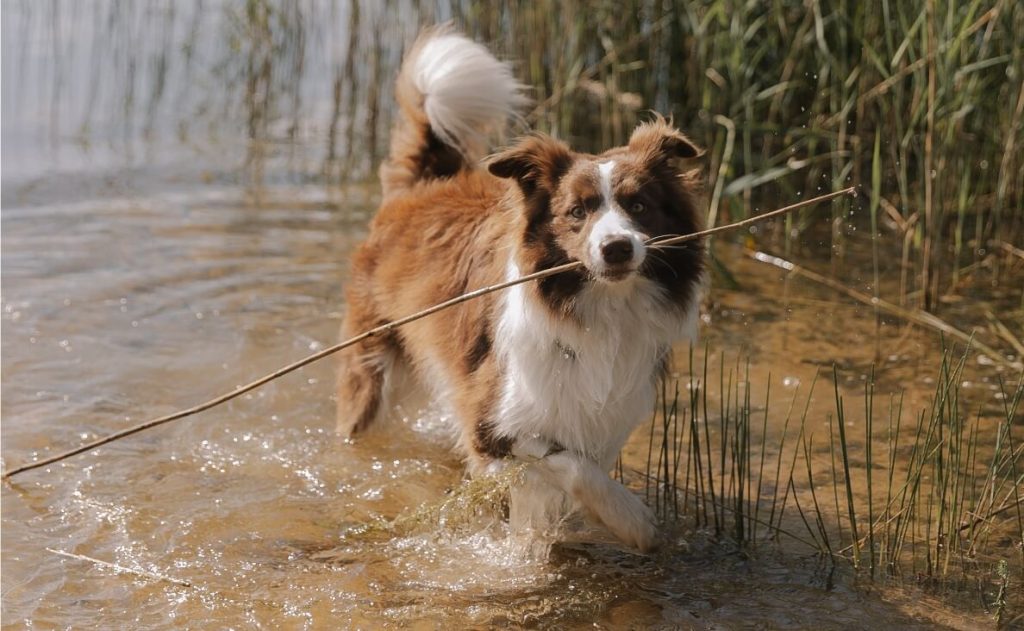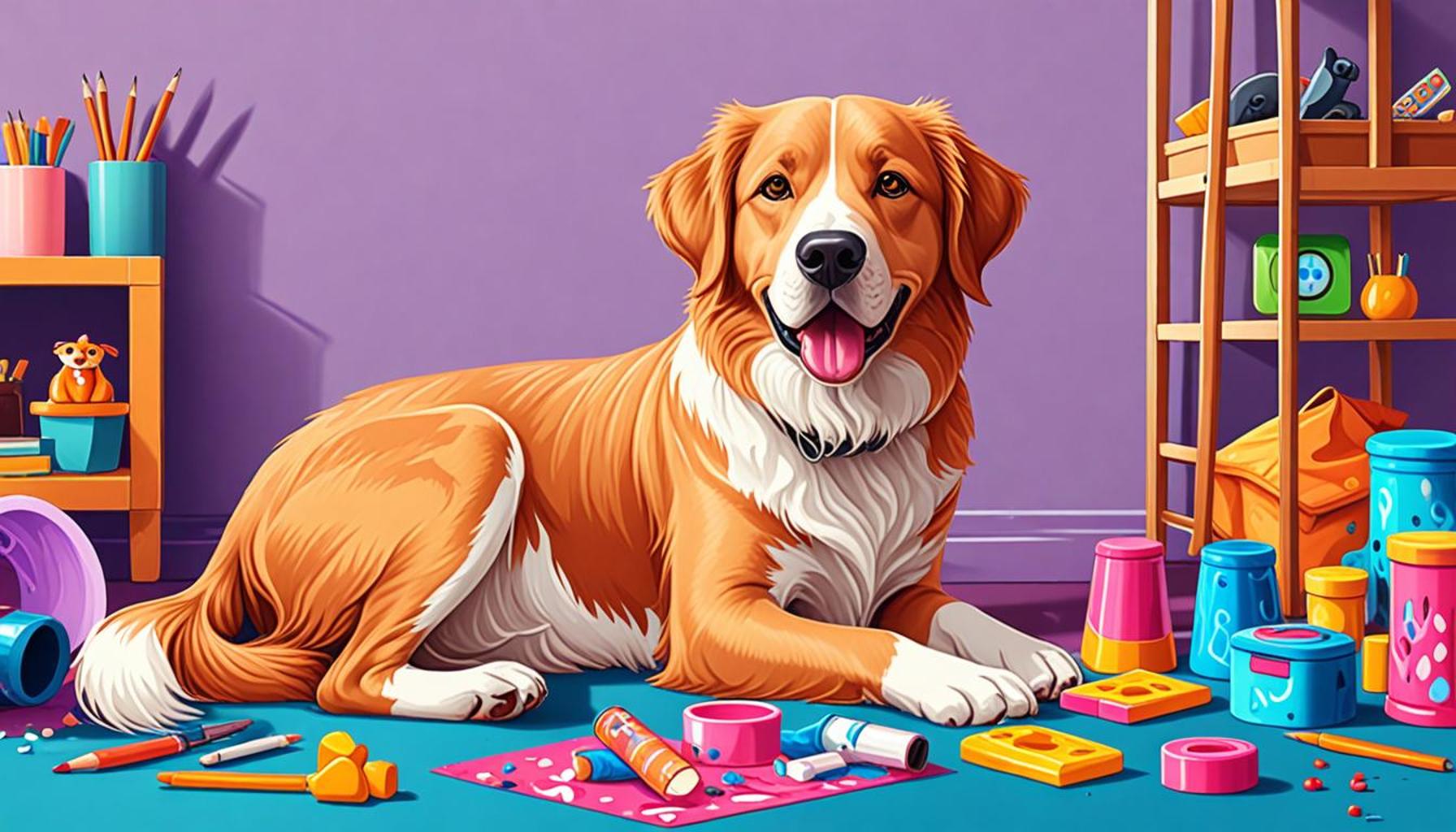How Environmental Enrichment Can Reduce Destructive Behaviors in Dogs

The Role of Environmental Enrichment in Dog Well-Being
Destructive behaviors in dogs, such as chewing furniture, digging, or excessive barking, can be a profound source of frustration for pet owners. These behaviors often emerge as a result of boredom, anxiety, or a lack of sufficient mental and physical stimulation. When dogs don’t have an engaging environment, they can exhibit these troublesome actions, jeopardizing the bond that we cherish with our furry companions. Recognizing the importance of environmental enrichment is essential in transforming a dog’s everyday life and ensuring their overall well-being.
At its core, environmental enrichment involves introducing various activities and adjustments to a dog’s living space that stimulate their senses and engage their minds. This proactive approach is not just beneficial; it can significantly reduce the likelihood of problematic behaviors. Here are some compelling benefits of environmental enrichment:
- Improved Mental Stimulation: Dogs are intelligent animals, and engaging toys—like puzzle feeders or interactive games—can challenge their cognitive abilities. For instance, toys that dispense treats when solved can encourage problem-solving, providing mental exercise that is crucial for their happiness.
- Physical Exercise: Activities that promote movement, such as agility courses or interactive fetch games, help reduce pent-up energy. A well-exercised dog is often a well-behaved dog. Regular physical activity not only curbs destructive behaviors but also contributes to a healthier life, preventing obesity and associated health issues.
- Enhanced Social Interaction: Opportunities for socialization, whether through playdates with other dogs or structured classes, can help curb anxiety and promote relaxation. Engaging with other dogs allows them to develop social skills and reduce feelings of isolation, which can be particularly beneficial for dogs that spend a significant amount of time alone.
Implementing environmental enrichment techniques can lead to not just happier, healthier dogs, but also a more satisfying experience for owners. By exploring various enrichment strategies—such as providing chewable items, setting up a routine for outdoor exploration, or incorporating training sessions that challenge your dog—owners can cater to their pets’ individual needs better. This exploration fosters a stronger, more harmonious relationship, allowing pet owners to connect with their dogs on a deeper level.
As we delve deeper into this topic, it’s crucial to discover how specific enrichment activities, like scent work or interactive feeding methods, can distinctly transform your dog’s behavior. Offering a variety of experiences not only enhances their quality of life but also enriches your shared moments, making every day with your dog an opportunity for learning and joy.
DISCOVER MORE: Click here for innovative techniques

Engaging the Mind: The Power of Mental Stimulation
One of the primary focuses of environmental enrichment is enhancing dogs’ mental stimulation, a critical element in reducing destructive behaviors. With varying intelligence levels and energy requirements across breeds, it’s essential to tailor activities that challenge your dog’s cognitive skills. Engaging toys, such as puzzle feeders, allow dogs to solve challenges that resemble natural behaviors, mimicking the hunt for food in the wild. This fun and engaging experience not only keeps dogs entertained but also helps to mitigate boredom, a major factor in destructive behaviors.
Studies indicate that mentally stimulated dogs are less likely to engage in harmful activities. According to research from the American Society for the Prevention of Cruelty to Animals (ASPCA), dogs who engage in regular mental challenges exhibit lower stress levels. Thus, incorporating interactive games into their daily routine can be a game-changer. Engaging your pet in activities that stimulate their minds can include:
- Puzzle Toys: Toys designed to dispense treats when manipulated can keep dogs occupied for long periods, offering an easily accessible method for mental engagement.
- Training Sessions: Consistent training not only teaches new commands but also reinforces the bond between owner and dog. Learning complex tricks can provide a significant challenge and deter unwanted behaviors.
- Hide and Seek: Playing this classic game with toys or even treats can encourage dogs to employ their natural hunting instincts, keeping them entertained while honing their problem-solving abilities.
Moreover, engaging a dog’s sense of smell can be paramount in mental stimulation. Dogs have an incredible sense of smell—estimated to be 10,000 to 100,000 times more sensitive than humans. Activities that utilize this informative sense can be particularly enriching. Scent work, such as hiding treats around the home or setting up scent trails outdoors, can challenge them effectively. Not only does this promote mental engagement, but it can also reduce stress and anxiety levels, making for a calmer pet at home.
Emphasizing the importance of physical exercise is another key aspect of environmental enrichment. A physically active dog often channels their energy positively, reducing the chances of engaging in destructive behaviors. Regular walks, trips to the dog park, and participation in agility training can fulfill a dog’s exercise needs while also serving as bonding experiences for the owner and pet.
Incorporating environmental enrichment into your dog’s day-to-day life is about more than just fun—it’s a vital component of responsible pet ownership. Being proactive in providing mental and physical stimulation can pave the way for a well-adjusted, content dog, resulting in fewer frustrations for both pet and owner. As you explore the various options available, remember that engaging their minds and bodies is fundamental to preventing those unwanted destructive behaviors that can disrupt your life together.
Understanding Environmental Enrichment: A Key Element in Canine Behavior
Environmental enrichment is a crucial concept that any pet owner should not overlook. By enhancing the dog’s surroundings, we can create a more stimulating environment that caters to their natural instincts and physical needs. Dogs, much like humans, thrive in settings that offer variety, challenge, and interest. The lack of stimulation can lead to destructive behaviors, such as chewing furniture, digging, or excessive barking.
The Role of Physical Activities
One effective way of fostering environmental enrichment is through physical activities tailored to a dog’s energy levels. Regular exercise is fundamental; activities like fetch or agility training can keep them engaged and physically stimulated. Owners also benefit from incorporating interactive toys that challenge dogs mentally and physically. Puzzle feeders, for instance, not only make mealtimes more engaging but also encourage dogs to problem-solve, which is essential for their cognitive development.
Socialization and Interactive Play
In addition to physical stimulation, socialization plays a vital role in enhancing a dog’s environment. Interacting with other dogs and people exposes them to various stimuli, helping them to become more adaptable and reducing anxiety-related behaviors. Playdates or dog parks can provide these valuable social experiences, allowing dogs to explore their social skills in a safe, supervised setting. Such interactions not only build confidence but also significantly reduce instances of unwanted behaviors.
Creating a Diverse Environment
Another aspect of environmental enrichment involves altering the dog’s living space. Incorporating different textures, scents, and sounds can engage their senses, making their world more dynamic. For example, consider rotating toys or introducing new scents into their environment, like safe spices or herbs. These small changes can impact dogs’ mental well-being, leading to a noticeable reduction in destructive tendencies.By focusing on environmental enrichment strategies, pet owners can create a living space that promotes healthy behavior and a happier, more satisfied dog. The strategies discussed can provide a strong foundation for any pet owner looking to enhance their dog’s quality of life and reduce challenging behaviors.
| Category | Key Aspects |
|---|---|
| Physical Activities | Engaging dogs in physical exercise helps burn excess energy and reduces destructive tendencies. |
| Socialization | Interacting with other dogs and people enhances adaptability and confidence, thereby minimizing anxiety-related behaviors. |
By exploring these environmental enrichment techniques, dog owners can significantly improve their pet’s behavior while fostering a healthier, more enriching home.
LEARN MORE: Click here to find out how to help your cat
Creating a Stimulating Environment: The Importance of Variety and Exploration
While mental stimulation is crucial, the environment in which a dog spends its time plays a significant role in their overall behavior. An enriched environment is one that encourages exploration, curiosity, and play, all of which can effectively diminish destructive behaviors. Dogs are naturally inquisitive creatures, and providing them with varied experiences can engage their senses and keep them from falling into boredom-induced mischief.
First and foremost, consider adding outdoor sensory experiences. Regular access to nature can provide dogs with new sights, sounds, and smells that stimulate their senses. Taking the time to explore different parks, hiking trails, or even your own backyard can lead to enriching encounters. For example, encounters with other animals and different terrains, such as grass, dirt, or water, can significantly enrich their daily routine. According to the American Kennel Club, exposing a dog to various environments can help in developing their adaptability, leading to lesser instances of stress and destructive outcomes.
Furthermore, introducing sensory toys can also enhance a dog’s environment. Toys that squeak, crinkle, or have varying textures can incite interest and promote active play. For instance, a toy stuffed with a variety of textures or featuring elements that emit different sounds can hold a dog’s attention much longer than a standard ball. Choosing toys that encourage different forms of play—such as tugging, chasing, and rolling—can elevate engagement levels and redirect any unwanted behavior.
- Rotating Toys: Instead of providing all toys at once, rotating them regularly adds a sense of novelty, preventing dogs from losing interest and stimulating their enthusiasm.
- Interactive Feeder Games: These encourage dogs to interact with their food while providing physical and mental challenges, turning mealtime into a fun and rewarding activity.
- Outdoor Exploration: Activities like hiking or swimming can introduce new challenges, promoting exercise and cognitive growth as dogs face new stimuli.
Another significant aspect of environmental enrichment is the introduction of playdates with other dogs. Socializing with other dogs can offer mental stimulation and physical activity, enhancing your dog’s overall well-being. Interacting with peers allows dogs to learn social cues and behaviors that are not only engaging but also crucial for their development. Pet owners should seek opportunities where dogs can play together safely, whether at dog parks or organized playgroups.
In addition, it’s essential to educate pet owners about altering their own behaviors to promote a more enriching environment for their dogs. Engaging in activities alongside your pet, such as agility training or teaching new tricks, can create significant bonding moments while also addressing behavioral issues. By imbuing playful interactions with structure, you can stimulate their minds while strengthening the human-animal bond.
In summary, diversifying a dog’s environment with sensory experiences, engaging toys, social opportunities, and active involvement from their owners can lead to a more approachable and well-behaved companion. Recognizing the significance of an enriched environment will significantly aid in the quest to reduce destructive behaviors, fostering a happier, healthier pet in the process.
DISCOVER MORE: Click here to learn how to make pet adoption more accessible
Conclusion: Elevating Canine Well-Being Through Enrichment
In conclusion, it is evident that environmental enrichment plays a pivotal role in cultivating harmonious relationships between dogs and their owners while significantly lessening the occurrence of destructive behaviors. By integrating a variety of stimulating elements into a dog’s daily routine—such as outdoor adventures, sensory toys, and opportunities for social interactions—pet owners can unlock their canine companions’ potential for joy and engagement. Each new experience not only boosts a dog’s mental and physical well-being but also fosters better behavior patterns and enhances adaptability to their surroundings.
The importance of a well-rounded environment cannot be overstated; it serves not just as a remedy for problematic behaviors but as a holistic approach to nurturing a dog’s spirit. Engaging in activities together, like training sessions or playdates, not only encourages exploration and curiosity but also enriches the bond between owner and pet. Furthermore, understanding how to provide a dynamic atmosphere tailored to a dog’s individual needs can empower owners to prevent boredom-induced mischief effectively.
As discussions around responsible pet ownership continue to evolve, embracing the principles of environmental enrichment may prove essential for dog owners across the United States. Ultimately, creating a stimulating and varied environment will not only minimize destructive behaviors but also pave the way for a happier, healthier, and more fulfilled life for our furry friends. By prioritizing their enrichment, we invest in their overall happiness and a deeper connection that benefits both parties.


